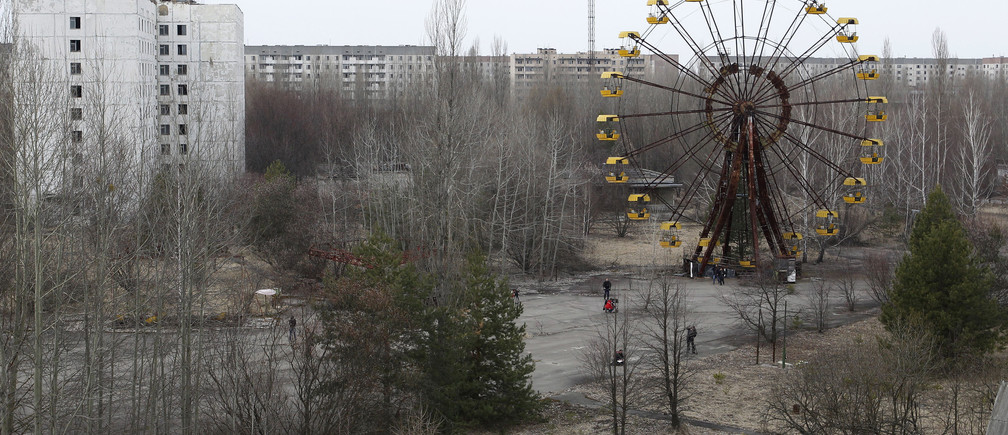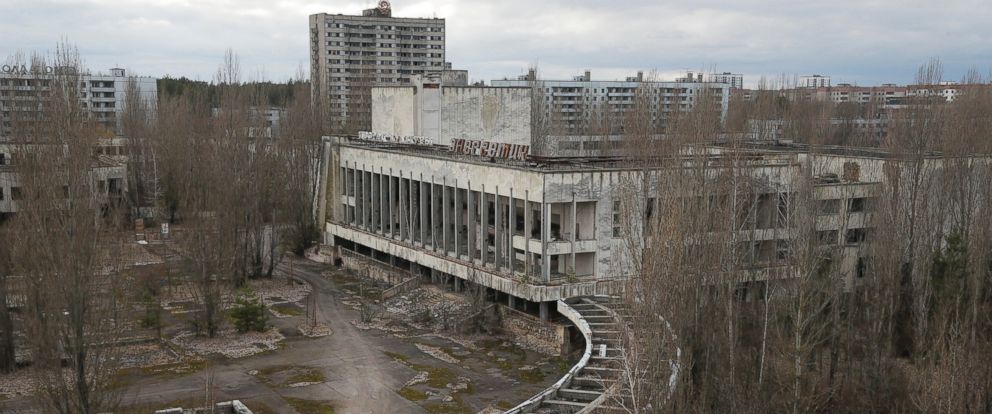
The Chernobyl disaster was a catastrophic nuclear accident that occurred on 25–26 April 1986 in the No. 4 nuclear reactor of the Chernobyl Nuclear Power Plant, near the now abandoned town of Pripyat, in northern Soviet Ukraine.
The disaster began during a systems test on 26 April 1986 at reactor 4 of the V. I. Lenin Nuclear Power Plant, near Pripyat and in proximity to the administrative border with Belarus and the Dnieper River.
During night time tests at the power plant, there was an unexpected power surge, and when operators attempted an emergency shutdown, a much larger spike in power output occurred. This second larger spike caused a reactor vessel to rupture resulting in a series of steam explosions. These events exposed the graphite moderator of the reactor to air, causing it to catch fire. For the next week, the resulting fire sent long plumes of highly radioactive fallout into the atmosphere over an extensive geographical area, including Pripyat. The plumes drifted over large parts of the western Soviet Union and Europe. According to official post-Soviet data, about 60% of the fallout landed in Belarus.

| Location | Radiation (roentgens per hour) | Sieverts per hour (SI Unit) |
|---|---|---|
| Vicinity of the reactor core | 30,000 | 300 |
| Fuel fragments | 15,000–20,000 | 150–200 |
| Debris heap at the place of circulation pumps | 10,000 | 100 |
| Debris near the electrolyzers | 5,000–15,000 | 50–150 |
| Water in the Level +25 feedwater room | 5,000 | 50 |
| Level 0 of the turbine hall | 500–15,000 | 5–150 |
| Area of the affected unit | 1,000–1,500 | 10–15 |
| Water in Room 712 | 1,000 | 10 |
| Control room | 3–5 | 0.03–0.05 |
| Hydropower Installation | 30 | 0.3 |
| Nearby concrete mixing unit | 10–15 | 0.10–0.15 |
To put these loose terms and numbers into perspective, below I have listed some dosage examples.
Dose examples
- 98 nSv: banana equivalent dose, an illustrative unit of radiation dose representing the measure of radiation from a typical banana
- 250 nSv: U.S. limit on effective dose from a single airport security screening
- 5–10 μSv: one set of dental radiographs
- 80 μSv: average dose to people living within 10 mi (16 km) of Three Mile Island accident
- 400–600 μSv: two-view mammogram, using weighting factors updated in 2007
- 1 mSv: U.S. 10 CFR dose limit for individual members of the public, total effective dose equivalent, per annum
- 1.5–1.7 mSv: annual dose for flight attendants
- 2–7 mSv: barium fluoroscopy, e.g. Barium meal, up to 2 minutes, 4–24 spot images
- 10–30 mSv: single full-body CT scan
- 50 mSv: U.S. 10 C.F.R. occupational dose limit, total effective dose equivalent, per annum
- 68 mSv: estimated maximum dose to evacuees who lived closest to the Fukushima I nuclear accident
- 80 mSv: 6-month stay on the International Space Station
- 160 mSv: chronic dose to lungs over one year smoking 1.5 packs of cigarettes per day, mostly due to inhalation of Polonium-210 and Lead-210
- 250 mSv: 6-month trip to Mars — radiation due to cosmic rays, which are very difficult to shield against
- 500 mSv: the U.S. 10 C.F.R occupational dose limit, shallow-dose equivalent to skin, per annum
- 670 mSv: highest dose received by a worker responding to the Fukushima emergency
- 1 Sv: maximum allowed radiation exposure for NASA astronauts over their career
- 4–5 Sv: dose required to kill a human with a 50% risk within 30 days (LD50/30), if the dose is received over a very short duration
- 4.5–6 Sv: fatal acute doses during Goiânia accident
- 5.1 Sv: fatal acute dose to Harry Daghlian in 1945 criticality acciden
- 10 to 17 Sv: fatal acute doses during Tokaimura nuclear accident. Hisashi Ouchi who received 17 Sv was kept alive for 83 days after the accident
- 21 Sv: fatal acute dose to Louis Slotin in 1946 criticality accident
- 36 Sv: fatal acute dose to Cecil Kelley in 1958, death occurred within 35 hours
- 54 Sv: fatal acute dose to Boris Korchilov in 1961 after a reactor cooling system failed on the Soviet submarine K-19 which required work in the reactor with no shielding.
- 64 Sv: nonfatal dose to Albert Stevens spread over ≈21 years, due to a 1945 plutonium injection experiment by doctors working on the secret Manhattan Project
On the day, there were 28 deaths due to radiation exposure and other hazards associated with the fallout. There have also been 15 estimated indirect deaths up to 2011, as a result of radiation exposure. The World health organisation estimates that there will be a further 4000 deaths in the next 50 years or so as a result of complications due to radiation exposure. These people in question weren’t even actively involved in the disaster, but lived in the surrounding areas and some affected live as far away as mid-Europe.





